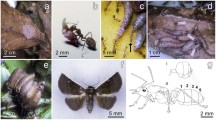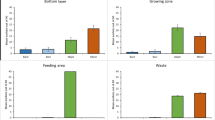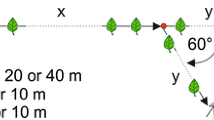Summary
Workers of Monomorium minimum forage above-ground for dead arthropods. Small particles (<1 mg) are retrieved individually, but larger particles stimulate recruitment and are dissected by groups of workers. The recruitment pheromone originates in the Dufour's gland and the number of ants responding to a trail varies with pheromone concentration. When ants of other species are encountered at food resources, workers of M. minimum gaster-flag and extrude an irritating poison gland secretion from the sting. This chemical interference delays invasion by competitors and prolongs the period during which the colony can dissect and retrieve pieces of the food resource. M. minimum recruits at higher temperatures than sympatric ant species. The probability of interference at food baits rises from 5% to 100% when they become too large for a single worker to carry. The probability of food resource loss is higher for baits of intermediate weight (x=18.1 mg) than for those of low weight (x=0.1 mg) or high weight (x=403.1 mg).
Similar content being viewed by others
References
Baroni Urbani C, Kannowski PB (1974) Patterns in the red imported fire ant settlement of a Louisiana pasture: Some demographic parameters, interspecific competition, and food sharing. Environ Entomol 3:755–760
Blum MS (1966) The source and specificity of trail pheromone in Termitopone, Monomorium and Huberia, and their relation to those of some other ants. Proc R Entomol Soc London 41:155–160
Blum MS, Jones TH, Hölldobler B, Jaouni T (1980) Alkaloidal venom mace: Offensive use by a thief ant. Naturwissenschaften 67:144–145
Brian MV (1955) Food collection by a Scottish ant community. J Anim Ecol 24:336–351
Brian MV, Hibble J, Kelly AF (1966) The dispersion of ant species in a southern English heath. J Anim Ecol 35:281–290
Cheesman LE, Crawley WC (1928) A contribution towards the insect fauna of French Oceania-Part III. Formicidae. Ann Mag Nat Hist Series 10 2:514–25
Goldstein E (1973) Ecology and biogeography of island ants. Ph D thesis. Yale University
Hölldobler B (1973) Chemische Strategie beim Nahrungserwerb der Diebsameise (Solenopsis fugax Latr.) und der Pharaoameise (Monomorium pharaonis L.). Oecologia (Berl) 11:371–380
Hölldobler B (1976) Recruitment behavior, home range orientation and territorality in harvester ants, Pogonomyrmex. Behav Ecol Sociobiol 1:3–44
Hölldobler B, Wilson EO (1978) The multiple recruitment systems of the African weaver ant Oecophylla longinoda (Latreille) (Hymenoptera: Formicidae). Behav Ecol Sociobiol 3:19–60
Hölldobler B, Stanton RC, Markl H (1978) Recruitment and foodretrieving behavior in Novomessor (Formicidae, Hymenoptera) I. Chemical signals. Behav Ecol Sociobiol 4:163–181
Levins R, Pressick ML, Heatwole H (1973) Coexistence patterns in insular ants. Am Sci 61:463–472
Miller RS (1967) Pattern and process in competition. Adv Ecol Res 4:1–74
Möglich MHJ, Alpert GD (1979) Stone dropping by Conomyrma bicolor (Hymenoptera: Formicidae): A new technique of interference competition. Behav Ecol Sociobiol 6:105–113
Oster G, Wilson EO (1978) Caste and ecology in the social insects. Princeton University Press, Princeton
Ritter FJ, Persoons CJ (1975) Recent development in insect pheromone research, in particular in the Netherlands. Neth J Zool 25:261–275
Talbot M (1953) Ants of an old-field community in the Edwin S. George Reserve, Livingston County, Michigan. Contrib Lab Vertebr Biol Univ Mich 63:1–13
Traniello JFA (1980) Studies on the behavioral ecology of north temperate ants. Ph D thesis. Harvard University
Author information
Authors and Affiliations
Rights and permissions
About this article
Cite this article
Adams, E.S., Traniello, J.F.A. Chemical interference competition by Monomorium minimum (Hymenoptera: Formicidae). Oecologia 51, 265–270 (1981). https://doi.org/10.1007/BF00540612
Received:
Issue Date:
DOI: https://doi.org/10.1007/BF00540612




